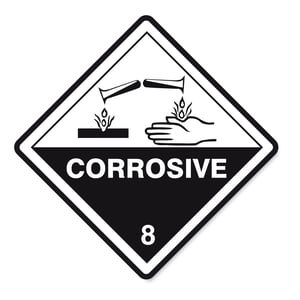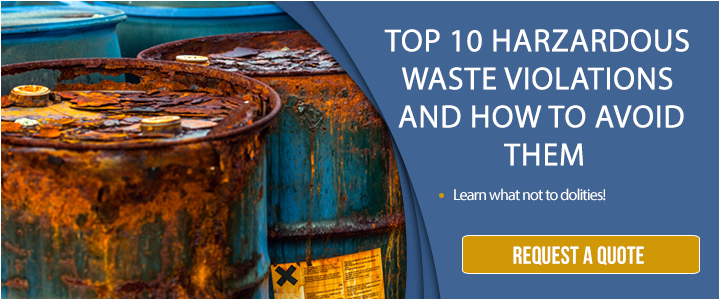The four characteristics of hazardous waste are:
- Ignitability
- Corrosivity
- Reactivity
- Toxicity
Knowing these four characteristics of hazardous waste helps businesses identify and manage the potential risks associated with the waste that they generate during industrial processes. Understanding these qualities also helps to ensure a company classifies its waste accurately, is compliant with regulations and guidelines, and minimizes potential risks to human health and the environment.
Ignitability
Ignitability is one of four characteristics of hazardous waste. When certain conditions exist, an ignitable waste can cause a fire. While many substances can catch fire, according to the U.S. Environmental Protection Agency, ignitable hazardous waste have the following criteria:
can cause a fire. While many substances can catch fire, according to the U.S. Environmental Protection Agency, ignitable hazardous waste have the following criteria:
- Substances that have a flashpoint of 60 degrees C or 140 degrees F. A flash point is the lowest temperature at which fumes from the waste will ignite.
- Waste that can spontaneously combust, which means to ignite or burst into flames without an external ignition source.
- Ignitable compressed gases and oxidizers.
Examples of ignitable hazardous waste include:
- Kerosene, gasoline and other waste oils
- Solvent-based paint waste
- Spent paint booth exhaust filters
Corrosivity
Corrosivity is one of four characteristics of hazardous waste. Corrosive wastes are strong acids or bases that have the ability to corrode or erode other materials. This type of hazardous waste typically has a pH level below 2, making it a strong acid, or a pH level above 12.5, making it a strong base.
the ability to corrode or erode other materials. This type of hazardous waste typically has a pH level below 2, making it a strong acid, or a pH level above 12.5, making it a strong base.
According to the United States Environmental Protection Agency, a liquid waste can be corrosive if it can corrode metal containers. Common metal containers used in industry today include storage tanks, drums and barrels.
Examples of corrosive hazardous waste include:
- Acid or alkaline cleaning solutions
- Alkaline degreasers
- Water or wastewater treatment chemicals
- Rust removers
- Battery acid
- Caustic hot tank waste
- Debris that is contaminated with corrosive substances
Reactivity
Reactivity is one of four characteristics of hazardous waste. Reactive wastes are “unstable under normal conditions,” according to the EPA. This means that this instability characteristic can cause explosions or release toxic gases, fumes or vapors at a standard temperature simply by mixing with water. Reactions can also occur when these contaminants are exposed to heat or are compressed.
Examples of reactive hazardous waste include:
- Cyanide plating wastes
- Unused explosives
- Pressurized aerosol cans
- Ethers
- Peroxides
- Metallic sodium and potassium
Toxicity
Toxicity is one of four characteristics of hazardous waste. Toxic wastes are harmful when ingested or absorbed. These wastes are particularly harmful if they do not go through proper hazardous waste disposal because they can leach into ground water or cause soil contamination. When soil becomes contaminated with toxic substances, it can impact nutrient imbalances, reduce plant growth and affect animals feeding on compromised plants.
Examples of toxic hazardous waste include:
- Painting wastes that contain toxic metal based pigments or certain types of solvents
- Treated wood waste in which the treatment used was pentachlorophenol
- Oily wastes that have excessive benzene levels
- Other substances like arsenic, cadmium, chloroform, lead, mercury, selenium, silver and trichloroethylene
How The Four Characteristics Of Hazardous Waste Impact Your Business
As a hazardous waste generator, knowing how each of the four characteristics of hazardous waste - ignitability, corrosivity, reactivity and toxicity - can impact your company’s operations is critical in ensuring you are compliant with regulations, protecting the environment and prioritizing your workers’ health and safety. Failing to do any of these can lead to potential liabilities including costly fines.
Regulatory Compliance
If your waste falls under one of four characteristics of hazardous waste, your business is subject to specific regulations and guidelines set by regulatory bodies like the EPA, U.S. Department of Transportation and OSHA (Occupational Safety and Health Administration).
Companies must be aware of these requirements and ensure their operations align with these laws and regulations in areas like classifying, labeling, transporting, storage and industrial waste disposal.
Storage And Handling
Characteristics of hazardous waste often determine the appropriate storage and handling practices. For example, flammable or reactive wastes may require specific storage conditions, including separate containers or designated areas to prevent accidental ignition or chemical reactions. Corrosive wastes may require corrosion-resistant containers or appropriate lining materials to prevent leaks or spills.
Proper labeling that includes information like the substance name, safety considerations and accumulation dates are also important in maintaining effective storage and handling procedures.
Employee Safety
In addition to storage and handling requirements, the characteristics of your hazardous waste in your facility can impact other areas of your operation like training. Employees need to be aware of the risks associated with each characteristic and understand the necessary precautions to mitigate those risks.
For example, employees should know how to handle and use personal protective equipment (PPE) when dealing with toxic or corrosive wastes. Comprehensive employee training programs ensure that people can identify and respond appropriately to hazardous waste characteristics.
Transportation And Shipping
Knowing what hazards your shipments pose is an important part of securing hazardous waste disposal. Proper packaging and containment methods are necessary to prevent leaks, spills and reactions during transportation. Regulations also govern what is on that packaging, including placards with pictograms and hazardous waste sign labels.
During transportation, placards provide visual warnings to emergency responders, transport workers and others about the potential hazards associated with any hazardous materials that are being transported. The U.S. Department of Transportation uses a standarized system of hazmat placards to identify the types of materials being transported.
You can read additional information and best practices for hazardous waste labels and placards in our article, Where To Get Free Printable Hazardous Waste Labels.
By understanding these four characteristics of hazardous waste, companies can prioritize safety, protect the environment and ensure the responsible management of a hazardous material, from its storage in a company’s facility to throughout the disposal process.


Comment